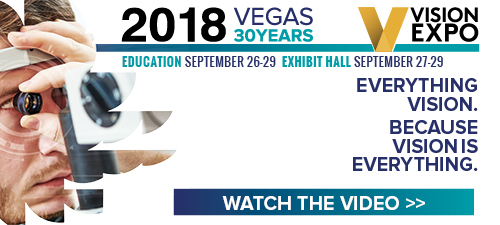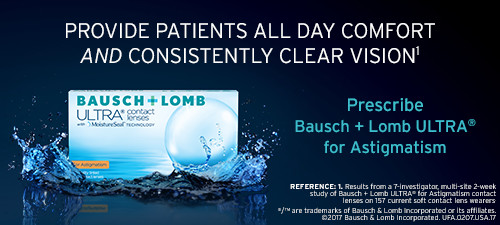
A
weekly e-journal by Art Epstein, OD, FAAO
Off the Cuff: VSP PROPOSED LEGISLATION - Take Action Before It’s Too Late
Craig Steinberg and I have been friends for many years. If you don’t know Craig or his work, you should. In addition to being an OD, he is also among the most knowledgeable and active lawyers representing optometry and optometric interests. I don’t know anyone more devoted to the profession or an individual who is more of a straight shooter than Craig. Much of his work involves representing ODs when they run afoul of VSP and other insurers. I have given Craig my weekly space to share some urgent and ominous news about VSP. I urge you to heed his words and call your state association and the AOA to ask that they take action to stop this proposed legislation before it seriously harms the profession. By as soon as early August it may be too late. Act now!
A Warning
|
|||||
|
||||
| Compliance To Topical Anti-Glaucoma Medications Among Patients At A Tertiary Hospital In North India | ||||
The present study aims to estimate the prevalence of non-compliance and improper drop administration technique among glaucoma patients and describe common obstacles to medication compliance. A hospital-based cross-sectional study, using a standardized questionnaire and direct observation by study personnel, was conducted among glaucoma patients aged 18 years and above at a tertiary care charitable eye hospital in North India. Researchers recruited 151 consecutive glaucoma patients on medical therapy with follow up at the glaucoma clinics for at least six months. Non-compliance was defined as missing at least one drop of medication per week and (or) the inability to accurately describe the medication regimen. Study personnel also assessed drop administration technique during application by patients treating ophthalmologist-provided information, including measures of disease stability. Factors such as socioeconomic status, presence of caregiver and number of medications with their effect on compliance were studied using chi-square statistics. Among the 151 patients interviewed, around 49% reported problems using glaucoma medications, with 16% of them reporting total non-compliance. Forgetfulness was cited as the main reason for being non-compliant and had a significant association with non-compliance. Paying patients were more compliant compared with subsidized patients. Disease was more stable in compliant patients compared with non-compliant patients. No other factor had significant association with compliance. More than 50% of the patients surveyed were non-compliant, and 35% demonstrated improper administration technique. Glaucoma patients should be educated on the importance of compliance and aids that minimize forgetfulness, and clinicians should consider systems facilitating the delivery of medications to the eye to enhance patient adherence. |
||||
SOURCE: Rajurkar K, Dubey S, Gupta PP, John D, Chauhan L. Compliance to topical anti-glaucoma medications among patients at a tertiary hospital in North India. J Curr Ophthalmol. 2018;30(2):125-129. |
||||
 |
||
| Physical Activity, Cardiorespiratory Fitness, and Incident Glaucoma | ||||
This study examined the associations of physical activity and cardiorespiratory fitness (hereafter fitness) with incident glaucoma in a prospective observational study. Physical activity was measured by self-reported leisure-time activities, and fitness was measured by maximal treadmill test. Incident glaucoma was defined based on physician diagnosis. Participants included 9,519 men and women between the ages of 40 and 81 years (mean age of 50) who were enrolled in the Aerobics Center Longitudinal Study. Hazard ratios were estimated using Cox proportional hazard regression after adjusting for age, sex, race, examination year, smoking status, heavy alcohol drinking, hypertension, hypercholesterolemia, abnormal electrocardiogram, diabetes, cardiovascular disease and cancer.
A total of 128 cases of incident glaucoma were reported during a mean follow-up of 5.7 years. A significantly lower risk of incident glaucoma (hazard ratio [HR] 0.53, 95% confidence interval [95% CI] 0.35-0.79), was found in individuals who met the physical activity guidelines of ≥500 metabolic equivalent-minutes (MET-min) per week compared with inactive individuals (0 MET-min/week). Compared with low fitness (lower third), individuals with high fitness (upper third) also had a significantly lower risk of incident glaucoma (HR 0.60, 95% CI 0.38-0.95). A joint analysis of physical activity and fitness showed that meeting physical activity guidelines and being in the high fitness category was associated with the lowest risk for developing glaucoma (HR 0.49, 95% CI 0.31-0.79). This study provides epidemiological evidence that meeting physical activity guidelines or being fit reduces the risk of developing glaucoma. |
||||
SOURCE: Meier NF, Lee DC, Sui X, Blair SN. Physical Activity, Cardiorespiratory Fitness, and Incident Glaucoma. Med Sci Sports Exerc. 2018 Jul 6. [Epub ahead of print]. |
||||
 |
||
| Effects Of Ripasudil, A ROCK Inhibitor, On Retinal Edema And Nonperfusion Area In A Retinal Vein Occlusion Murine Model | ||||
Rho-associated coiled-coil containing protein kinase (ROCK) inhibitors are used to treat glaucoma patients and have protective effects on ischemic states. However, it is poorly understood how the ROCK pathway affects the pathological signs of retinal vein occlusion (RVO). In this study, researchers evaluated the effects of ripasudil, a ROCK inhibitor, on a murine RVO model. In vivo, RVO was induced by retinal vein laser irradiation in mice, and evaluated after treatment with ripasudil. In vitro, the effects of ripasudil were examined on tight junction protein integrity in human retinal microvascular endothelial cells (HRMECs). Moreover, they investigated the expression level of the phosphorylated myosin phosphatase target protein (MYPT)-1 after administration of ripasudil. Ripasudil significantly prevented deterioration, such as retinal edema, reduced the size of the nonperfusion area and improved retinal blood flow. Ripasudil treatment inhibited disintegration of ZO-1 in HRMECs. Administration of ripasudil suppressed retinal phosphorylation of MYPT-1 in the murine RVO model. These findings indicate that ripasudil might be a possible therapeutic agent for RVO. |
||||
SOURCE: Hida Y, Nakamura S, Nishinaka A, et al. Effects of ripasudil, a ROCK inhibitor, on retinal edema and nonperfusion area in a retinal vein occlusion murine model. J Pharmacol Sci. 2018 Jun 19. [Epub ahead of print]. |
||||
 |
||
| News & Notes | ||||||||
X-Cel Specialty Contacts Announces Scleral Lens Patient Care Kits |
||||||||
Oyster Point Pharma Announces Positive Results from Phase 2 Clinical Trial of the Company’s Investigational Treatment for Dry Eye Disease
|
||||||||
| RGN-259 (Tβ4) Improves Clinically Important Dry Eye Efficacies in Comparison with Prescription Drugs RegeneRx Biopharmaceuticals recently announced a new study comparing RGN-259 with currently approved prescription products for dry eye syndrome (DES) demonstrated that after 10 days of treatment, RGN-259 performed equal to or better than cyclosporine A, lifitegrast and diquafosol. The study parameters measured were tear production, corneal smoothness and decreased fluorescein staining, as well as corneal epithelial detachment, conjunctival goblet cells, mucin production and expression of inflammatory factors. RGN-259 was equal to or better than the other approved products in each case, according to a company news release. Read more. |
||||||||
|
Optometric Physician™ (OP) newsletter is owned and published by Dr. Arthur Epstein. It is distributed by the Review Group, a Division of Jobson Medical Information LLC (JMI), 11 Campus Boulevard, Newtown Square, PA 19073. HOW TO ADVERTISE |



